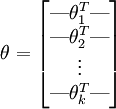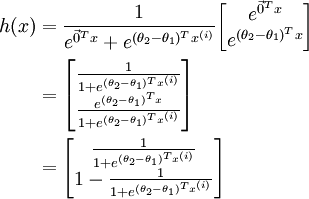【机器学习】Softmax 和Logistic Regression回归Sigmod
二分类问题Sigmod
在 logistic 回归中,我们的训练集由  个已标记的样本构成:
个已标记的样本构成: ,其中输入特征
,其中输入特征 。(我们对符号的约定如下:特征向量
。(我们对符号的约定如下:特征向量  的维度为
的维度为  ,其中
,其中  对应截距项 。) 由于 logistic 回归是针对二分类问题的,因此类标记
对应截距项 。) 由于 logistic 回归是针对二分类问题的,因此类标记  。假设函数(hypothesis function) 如下:
。假设函数(hypothesis function) 如下:
我们将训练模型参数  ,使其能够最小化代价函数 :
,使其能够最小化代价函数 :
多分类问题
在一个多分类问题中,因变量y有k个取值,即 。例如在邮件分类问题中,我们要把邮件分为垃圾邮件、个人邮件、工作邮件3类,目标值y是一个有3个取值的离散值。这是一个多分类问题,二分类模型在这里不太适用。
。例如在邮件分类问题中,我们要把邮件分为垃圾邮件、个人邮件、工作邮件3类,目标值y是一个有3个取值的离散值。这是一个多分类问题,二分类模型在这里不太适用。
主要应用就是多分类,sigmoid函数只能分两类,而softmax能分多类,softmax是sigmoid的扩展。
Logistic函数只能被使用在二分类问题中,但是它的多项式回归,即softmax函数,可以解决多分类问题。
在 softmax回归中,我们解决的是多分类问题(相对于 logistic 回归解决的二分类问题),类标  可以取
可以取  个不同的值(而不是 2 个)。因此,对于训练集
个不同的值(而不是 2 个)。因此,对于训练集  ,我们有
,我们有  。(注意此处的类别下标从 1 开始,而不是 0)
。(注意此处的类别下标从 1 开始,而不是 0)
对于给定的测试输入  ,我们想用假设函数针对每一个类别j估算出概率值
,我们想用假设函数针对每一个类别j估算出概率值  。也就是说,我们想估计
。也就是说,我们想估计  的每一种分类结果出现的概率。因此,我们的假设函数将要输出一个
的每一种分类结果出现的概率。因此,我们的假设函数将要输出一个  维的向量(向量元素的和为1)来表示这
维的向量(向量元素的和为1)来表示这  个估计的概率值。 具体地说,我们的假设函数
个估计的概率值。 具体地说,我们的假设函数  形式如下:
形式如下:
其中  是模型的参数。请注意
是模型的参数。请注意  这一项对概率分布进行归一化,使得所有概率之和为 1 。
这一项对概率分布进行归一化,使得所有概率之和为 1 。
为了方便起见,我们同样使用符号  来表示全部的模型参数。在实现Softmax回归时,将
来表示全部的模型参数。在实现Softmax回归时,将  用一个
用一个  的矩阵来表示会很方便,该矩阵是将
的矩阵来表示会很方便,该矩阵是将  按行罗列起来得到的,如下所示:
按行罗列起来得到的,如下所示:
代价函数
 值为假的表达式
值为假的表达式  。举例来说,表达式
。举例来说,表达式  的值为1 ,
的值为1 , 的值为 0。我们的代价函数为:
的值为 0。我们的代价函数为:
值得注意的是,上述公式是logistic回归代价函数的推广。logistic回归代价函数可以改为:
可以看到,Softmax代价函数与logistic 代价函数在形式上非常类似,只是在Softmax损失函数中对类标记的 k 个可能值进行了累加。注意在Softmax回归中将 x 分类为类别  的概率为:
的概率为:
 .
.
对于  的最小化问题,目前还没有闭式解法。因此,我们使用迭代的优化算法(例如梯度下降法,或 L-BFGS)。经过求导,我们得到梯度公式如下:
的最小化问题,目前还没有闭式解法。因此,我们使用迭代的优化算法(例如梯度下降法,或 L-BFGS)。经过求导,我们得到梯度公式如下:
让我们来回顾一下符号 " " 的含义。
" 的含义。 本身是一个向量,它的第
本身是一个向量,它的第  个元素
个元素  是
是  对
对 的第
的第  个分量的偏导数。
个分量的偏导数。
有了上面的偏导数公式以后,我们就可以将它代入到梯度下降法等算法中,来最小化  。 例如,在梯度下降法的标准实现中,每一次迭代需要进行如下更新:
。 例如,在梯度下降法的标准实现中,每一次迭代需要进行如下更新:  (
( )。
)。
当实现 softmax 回归算法时, 我们通常会使用上述代价函数的一个改进版本。
Softmax回归与Logistic 回归的关系
当类别数  时,softmax 回归退化为 logistic 回归。这表明 softmax 回归是 logistic 回归的一般形式。具体地说,当
时,softmax 回归退化为 logistic 回归。这表明 softmax 回归是 logistic 回归的一般形式。具体地说,当  时,softmax 回归的假设函数为:
时,softmax 回归的假设函数为:
利用softmax回归参数冗余的特点,我们令  ,并且从两个参数向量中都减去向量
,并且从两个参数向量中都减去向量  ,得到:
,得到:
因此,用  来表示
来表示 ,我们就会发现 softmax 回归器预测其中一个类别的概率为
,我们就会发现 softmax 回归器预测其中一个类别的概率为  ,另一个类别概率的为
,另一个类别概率的为  ,这与 logistic回归是一致的。
,这与 logistic回归是一致的。
广义线性模型
这些分布之所以长成这个样子,是因为我们对y进行了假设。
当y是两点分布-------->linear model
当y是正态分布-------->Logistic model
当y是多项式分布-------->Softmax
http://ufldl.stanford.edu/wiki/index.php/Softmax回归#Softmax.E5.9B.9E.E5.BD.92.E4.B8.8ELogistic_.E5.9B.9E.E5.BD.92.E7.9A.84.E5.85.B3.E7.B3.BB


![\begin{align}
J(\theta) = -\frac{1}{m} \left[ \sum_{i=1}^m y^{(i)} \log h_\theta(x^{(i)}) + (1-y^{(i)}) \log (1-h_\theta(x^{(i)})) \right]
\end{align}](http://ufldl.stanford.edu/wiki/images/math/f/a/6/fa6565f1e7b91831e306ec404ccc1156.png)


![\begin{align}
J(\theta) = - \frac{1}{m} \left[ \sum_{i=1}^{m} \sum_{j=1}^{k} 1\left\{y^{(i)} = j\right\} \log \frac{e^{\theta_j^T x^{(i)}}}{\sum_{l=1}^k e^{ \theta_l^T x^{(i)} }}\right]
\end{align}](http://ufldl.stanford.edu/wiki/images/math/7/6/3/7634eb3b08dc003aa4591a95824d4fbd.png)
![\begin{align}
J(\theta) &= -\frac{1}{m} \left[ \sum_{i=1}^m (1-y^{(i)}) \log (1-h_\theta(x^{(i)})) + y^{(i)} \log h_\theta(x^{(i)}) \right] \\
&= - \frac{1}{m} \left[ \sum_{i=1}^{m} \sum_{j=0}^{1} 1\left\{y^{(i)} = j\right\} \log p(y^{(i)} = j | x^{(i)} ; \theta) \right]
\end{align}](http://ufldl.stanford.edu/wiki/images/math/5/4/9/5491271f19161f8ea6a6b2a82c83fc3a.png)
![\begin{align}
\nabla_{\theta_j} J(\theta) = - \frac{1}{m} \sum_{i=1}^{m}{ \left[ x^{(i)} \left( 1\{ y^{(i)} = j\} - p(y^{(i)} = j | x^{(i)}; \theta) \right) \right] }
\end{align}](http://ufldl.stanford.edu/wiki/images/math/5/9/e/59ef406cef112eb75e54808b560587c9.png)



 浙公网安备 33010602011771号
浙公网安备 33010602011771号